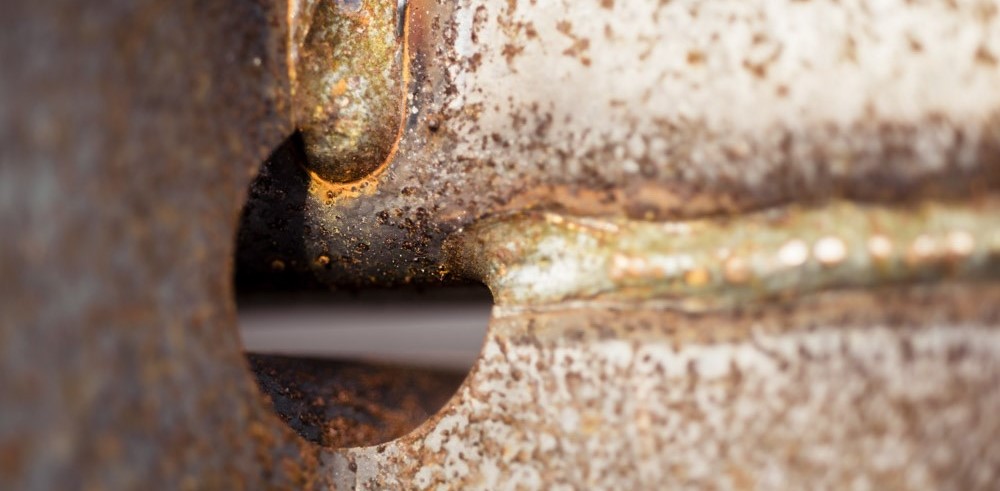What is corrosion?
Causes, types, and how to prevent corrosion
Corrosion can affect various materials, causing deterioration and damage. If left untreated, corrosion can be visually unappealing at best or an expensive safety hazard at worst.
We define corrosion, its causes and types, as well as preventative measures to help you better understand and combat the steel deterioration process.

Corrosion definition
Corrosion is the gradual deterioration of materials, caused by chemical reactions with the environment. It is a natural process and is most associated with metals, but it can also affect other materials like ceramics and plastics. The corrosion process happens when a material reacts with substances such as oxygen, water, acids, or salts, leading to the breakdown of its structure.
Causes of corrosion
Several factors contribute to the corrosion process. The primary causes of the corrosion of metal are from external variables, including moisture, oxygen, and chemicals. We cover these causes of corrosion in more detail.
Moisture
When metals collect moisture, an electrochemical reaction causes the steel to corrode. The corrosion process is often accelerated by dissolved salts or impurities in the water.
Oxygen
Oxygen reacts with metal atoms, forming metal oxides – otherwise known as rust. Rust is just one type of corrosion, but it’s one of the biggest types to affect steel.
Unless the steel is kept in an oxygen-free environment, it will slowly rust over time, even if you take good care of it. Both oxygen and moisture are required for steel to rust.
Chemicals
Acidic substances can corrode metals by attacking their surface. Industrial processes, pollution, and even natural sources like acid rain can introduce acids to the environment, increasing the risk of corrosion. Certain industries, such as construction or agriculture, may have an increased prevalence of chemicals that may contribute to metal corrosion.

Types of corrosion
You may assume that all corrosion is the same, but this is not the case. There are many forms of corrosion, each with distinct characteristics and causes. The most common types include uniform corrosion, pitting corrosion, and galvanic corrosion.
Uniform corrosion
Uniform corrosion occurs evenly across the surface of the material, resulting in a gradual loss of material thickness. Uniform corrosion is typically caused when metal is exposed to moisture or atmospheric conditions.
Because the corrosion happens evenly across the whole structure, it is easy to spot. It is also one of the easiest types of metal corrosion to prevent.
Pitting corrosion
Pitting corrosion is when holes form in the metal surface. It often starts with a small scratch, which then becomes an active site for corrosion, localised to the point of abrasion. Pitting corrosion can be particularly destructive, leading to rapid damage.
Unlike uniform corrosion, pitting corrosion can be harder to spot because the corrosion occurs within the crevices formed. It is also harder to prevent than uniform corrosion.
Crevice corrosion
Crevice corrosion is very similar to pitting corrosion, initially occurring from damage to the protective layers of the metal. However, crevice corrosion usually doesn’t affect the surface and forms within the crevices of joined steel, such as the corners. It can spread much more rapidly than pitting corrosion.
Galvanic corrosion
Galvanic corrosion occurs, also known as bimetallic corrosion, occurs when two different metals with dissimilar electric potentials come into contact in the presence of an electrolyte, such as moisture. The metal that is more reactive will corrode more quickly than usual as the electricity passes between the two metals, while the less reactive metal will be protected. The metal that corrodes quicker acts as an anode, while the protected metal acts as a cathode.
Mixed metal fabrications have a higher chance of galvanic corrosion.

How to prevent corrosion
Metal corrodes very quickly without a protective coating, such as galvanizing. Preventive measures can help minimise the risk and impact of corrosion. Environmental changes can also help slow down the corrosion process.
Galvanizing
Hot dip galvanizing involves dipping steel into a bath of molten zinc, causing a chemical reaction where the zinc metallurgically bonds with the steel. As the zinc and steel atoms bond, it makes the steel very durable and corrosion-resistant, providing cathodic protection for the underlying steel. Galvanizing is among the most effective ways to protect steel against corrosion and is cheaper in the long term compared to alternatives.
Top-layer coatings
Applying a surface coating such as powder coating or paint can protect steel against corrosion. Top-layer coatings can also be used after the steel has been galvanized to enhance the steel’s longevity. Both powder coating and paint can also be used to add colour to steel structures.
Combining hot dip galvanizing and powder coating on the same steel structure is known as a duplex coating. Using galvanizing and powder coating together provides numerous benefits for steel, included an extended lifespan and reduced costs.
Environmental changes
Changing your environment can reduce the rate of corrosion. However, this may not always be possible, especially if the steel is outside or near corrosive chemicals.

How to remove rust from metal
There is still hope if your steel has started to corrode. A surface-cleaning technique such as shot blasting can remove any existing rust off the steel. While shot blasting on its own won’t prevent rust from building up again, it is a crucial step before galvanizing to make the process more effective.
If your steel is very rusty, it may not be possible to recover. In the future, book in with a reputable galvanizing company as soon as possible after steel fabrication.
By understanding the causes and types of corrosion, as well as implementing preventive measures, it is possible to minimise its impact.
Joseph Ash Galvanizing can remove rust from your steel and increase your steel’s resistance against corrosion. Find your nearest site and get a quote today.